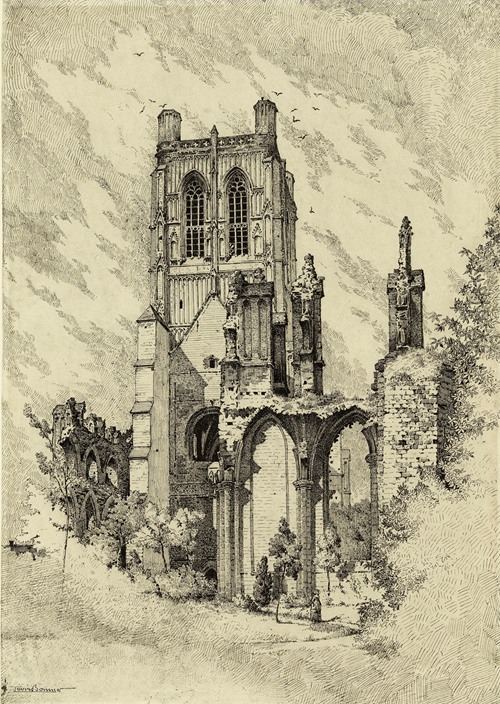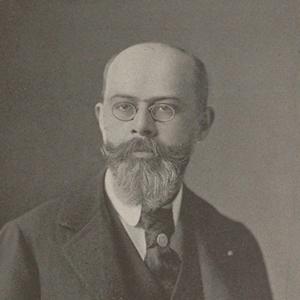




Louis Bernard Bonnier was a French architect known for his work as an urban planner for the city of Paris. He was instrumental in loosening the restrictions on the appearance of buildings in Paris, which resulted in the blossoming of Art Nouveau buildings. He designed many significant buildings himself, including private villas, public housing and railway buildings. In all his work he was true to the rationalist principles of Art Nouveau.
Louis Bernard Bonnier was born on 14 June 1856 in Templeuve, Nord. The Bonnier family were originally laborers. Louis Bonnier was the son of a notary's clerk who later became manager of a sugar factory and then a wine salesman. Louis's father was a committed Republican. Louis was the oldest of four boys. His brothers were Charles (1803–1926), Pierre Bonnier (1861–1918) and Jules (1859–1908). Jules Bonnier became a well-known biologist.
Bonnier studied painting and architecture at the École académique de Lille. He was admitted to the École nationale supérieure des Beaux-Arts in Paris in 1877, where he was a pupil of André Moyaux and Louis-Jules André. Bonnier married Isabelle Deconchy on 25 April 1881. She was the sister of his friend Ferdinand Deconchy, a painter, and daughter of a well-known architect. They had three sons. Jean (1882–1966) was a painter and decorator, Jacques (1884–1964) was an architect and Marc (1887–1916) was an aviator. Louis Bonnier graduated from the École des Beaux-Arts in 1886.
Examples of Bonnier's early work were four houses he built in Ambleteuse, Nord (1892), the town hall in Templeuve (1893) and the Flé house in Ambleteuse (1894). These illustrated his taste for rationality, economy and subordination of decoration to structure. With his work on the town hall at Issy-les-Moulineaux he showed his ability to discard period styles of architecture and to make use of new materials. This made his work attractive to the nouveau-riche. He was named Architect of the City of Paris in 1884.
Bonnier shared an interest in Japanese prints and stencil patterns with Siegfried Bing, and in 1895 was the main architect and designer for the renovation of Bing's shop at 22 rue de Provence in Paris, the Maison de l'Art Nouveau. Bing had first asked Victor Horta for plans, but had rejected them as too expensive. Bonnier designed the grillwork for the entrance to the Japanese section of the shop on Rue Chauchat, and oversaw placement of the glass cupola over the corner turret. He oversaw the decorations and architectural changes to the shop, working with artisans such as Frank Brangwyn, an English Arts and Crafts designer. The shop opened in December 1895.
The success of Bing's shop led to further commissions. He designed a globe based on the concept of the anarchist geographer Élisée Reclus for the Paris Exposition Universelle (1900). This was not built. He also designed the impressive Schneider Pavilion on the Quai Branly for the exposition. Schneider was the main supplier of guns and armaments, and Bonnier designed a red building situated on the bank of the Seine that resembled a huge gun turret or battery. The pavilion gained widespread press attention and consolidated Bonnier's reputation as an architect capable of innovative solutions to unusual challenges.
Bonnier was responsible for the report of the commission that reviewed the decrees regulating construction in Paris, and prepared the decree of 13 August 1902 that gave more freedom in the appearance to buildings. This allowed for new buildings in the Art Nouveau style, and for structures that let more air and light into the streets and yards. In 1910 he became director of architecture services, plantations and walks. He was also Inspector General of Architectural Technical Services and Aesthetics of the Seine, and Chief Architect for Civil Buildings and National Palaces. He was responsible for the Elysée Palace from 1901 to 1911. In 1912 he oversaw the first Habitation à bon marché (HBM) low-cost housing competition of the city of Paris, and made the first plan for expansion of Paris with Marcel Poëte.
In 1916 Bonnier proposed the creation of the archaeological and artistic depository of the prefecture of the Seine. He founded the Ecole supérieure d’art public in 1917, which became the École des hautes études urbaines (EHEU) in 1919. The school taught modern urban planning concepts. It bought the journal La Vie urbaine, which Bonnier and Poëte had founded. Bonnier taught there until 1924, when the EHEU became the Urban Planning Institute of the University of Paris. Bonnier built the Butte-aux-Cailles swimming pool (1920–23), and a group of HMB buildings in Ménilmontant (1920–25). From 1920 he was consulting architect to the PLM Railway Company, and supervised or directed construction of new stations and hotel accommodations. His last task before retiring was to manage the architecture services and works for the Exposition Internationale des Arts Décoratifs of 1925. His work was part of the architecture event in the art competition at the 1928 Summer Olympics.
He died in Paris in 1946.


